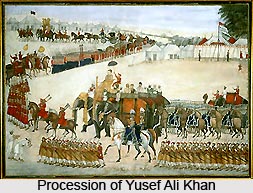 Yusef Ali Khan or Yusuf Ali Khan, also known as Nawab Muhammad Yusef Ali Khan Bahadur, KSI, was one of the most well known rulers or Nawabs of the princely state of Rampur, which is currently in the state of Uttar Pradesh in India. He was born on 5 March 1816 and ruled over the territory from the year 1855 to 1865. During the great revolt of 1857 Yusuf Ali provided several essential services to the Indian Government through proper maintenance of British supply and communication lines to Nainital operational releasing and saving fugitives and protecting the town of Moradabad. For the many services provided by Nawab Muhammad Yusef Ali Khan Bahadur was knighted in the year 1861 and was given extensive lands in the region of Bareilly by Lord Canning, the Viceroy of India. He was also honoured by 13 gun salute along with the style of His Highness.
Yusef Ali Khan or Yusuf Ali Khan, also known as Nawab Muhammad Yusef Ali Khan Bahadur, KSI, was one of the most well known rulers or Nawabs of the princely state of Rampur, which is currently in the state of Uttar Pradesh in India. He was born on 5 March 1816 and ruled over the territory from the year 1855 to 1865. During the great revolt of 1857 Yusuf Ali provided several essential services to the Indian Government through proper maintenance of British supply and communication lines to Nainital operational releasing and saving fugitives and protecting the town of Moradabad. For the many services provided by Nawab Muhammad Yusef Ali Khan Bahadur was knighted in the year 1861 and was given extensive lands in the region of Bareilly by Lord Canning, the Viceroy of India. He was also honoured by 13 gun salute along with the style of His Highness.
Eventually Sir Yusef Ali Khan became a member of the Council of the Viceroy. Although he was honoured repeatedly by the British East India Company, the Nawab of Rampur continued to conserve the Mughal artistic tradition and invited artists, scholars and musicians, who were part of the court of Bahadur Shah Zafar II, to settle and prosper at Rampur; this also included the great poet Ghalib. He died at the age on 49 on 21st April 1865 and was succeeded by Sir Kalb Ali Khan Bahadur, who was his son.
Titles of Yusef Ali Khan
Nawab Muhammad Yusef Ali Khan Bahadur, Nawab of the princely state of Rampur held many titles. These are mentioned below-
* Nawabzada Muhammad Yusef Ali Khan, Wali Ahad Bahadur (1816- 1855)
* Ali Jah, Mukhlis ud-Daula, Nasir ul-Mulk, Amir ul-Umara, Nawab Muhammad Yusuf Ali Khan Bahadur, Mustaid Jang, Nawab of Rampur (1855- 1860)
* Ali Jah, Farzand-i-Dilpazir, Mukhlis ud-Daula, Nasir ul-Mulk, Amir ul-Umara, Nawab Muhammad Yusuf Ali Khan Bahadur, Mustaid Jang, Nawab of Rampur (1860- 1861)
* His Highness Ali Jah, Farzand-i-Dilpazir, Mukhlis ud-Daula, Nasir ul-Mulk, Amir ul-Umara, Nawab Sir Muhammad Yusuf Ali Khan Bahadur, Mustaid Jang, Nawab of Rampur, KSI (1861-1865)
Honours of Yusef Ali Khan
Nawab Yusef Ali Khan was honoured with the Knight Companion of the Order of the Star of India (KSI) in the year 1861.



















